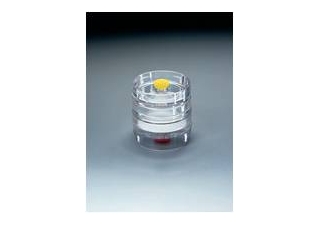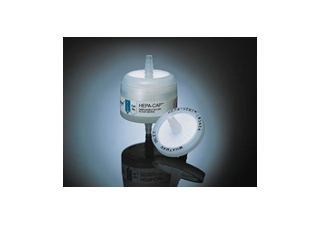Used in a variety of sample cleanup, prefiltration, and analytical testing applications. Choose between binder-free borosilicate glass for complete purity or glass fiber with acrylic binder for added strength.
Type A/E Glass Fiber
- For testing dissolved and suspended solids in wastewater and gravimetric analysis of air pollutants.
- High flow rates, wet strength, and dirt (solids) holding capacities.
Type A/B Glass Fiber
- High dirt-loading capacity with 2.5 times thicker glass than Type A/C.
- Manufactured of the highest quality borosilicate glass microfibers.
Type A/C Glass Fiber
- For testing dissolved and suspended solids in wastewater.
- 254 µm (10 mils) thickness is useful for cell harvesting applications.
- Purity eliminates risk of unwanted contaminants leaching into the filtrate.
Type A/D Glass Fiber
- Excellent prefilters for solutions with a heavy load of large-sized particulate that must be removed.
- Large nominal pore size (3 µm) reduces membrane clogging.
Extra Thick Glass Fiber
- Preferred for prefiltration of viscous biological solutions.
- High particulate-holding capacity makes discs efficient depth filters and allows for filtration of large volumes of solutions.
Metrigard™ Glass Fiber
- Useful for prolonging membrane filter life in liquid systems that contain substantial amounts of particulate matter.
| Specifications and Selection Chart |
| Description |
Type A/E |
Type A/B |
Type A/C |
Type A/D |
Extra Thick |
Metrigard™ Discs |
| Typical Applications |
Water solids testing, air monitoring, gravimetric analysis |
Diagnostic applications, sample prefiltration |
Cell harvesting, prefiltration, solids testing |
Prefiltration of solutions with large-sized particulate |
Prefiltration of heavily contaminated samples |
Prefiltration in systems with high particulate matter |
| Filter Media |
Borosilicate glass without binder |
Borosilicate glass without binder |
Borosilicate glass without binder |
Borosilicate glass without binder |
Glass fiber with acrylic binder** |
Ultrafine glass fiber with acrylic binder** |
| Pore Size (nominal) |
1 µm |
1 µm |
1 µm |
3 µm |
1 µm |
0.5 µm |
| Typical Thickness |
330 µm
(13 mils) |
660 µm
(26 mils) |
254 µm
(10 mils) |
660 µm
(26 mils) |
1270 µm
(50 mils) |
330 µm
(13 mils) |
| Typical Water Flow Rate L/min/cm2 at 0.3 bar (30 kPa, 5 psi) |
250 |
124 |
153 |
649 |
210 |
80 |
| Typical Air Flow Rate L/min/cm2 at 0.7 bar (70 kPa, 10 psi) |
68 |
24 |
40 |
139 |
26 |
21 |
| Maximum Operating Temperature |
Air
550° C
(1022° F) |
Air
550° C
(1022° F) |
Air
550° C
(1022° F) |
Air
550° C
(1022° F) |
Water
135° C
(275° F) |
Water
135° C
(275° F) |
| Sterilization |
Autoclavable |
Autoclavable |
Autoclavable |
Autoclavable |
Autoclavable |
Autoclavable |
| Typical Aerosol Retention* |
99.98% |
- |
- |
- |
99.97% |
99.99% |
*Following ASTM D 2986-95A 0.3 µm (DOP) at 32 L/min/100 cm2 filter media.
**Binder is 5% of total material. |
Qualitative Paper Filters
P1 Grade - Medium flow rate and retention
- Air pollution testing where atmospheric dust is collected and the stain-intensity measured photometrically.
- Testing for aluminum phosphate, barium, carbonate, lead chromate, and beryllium hydroxide.
- Typically used for clarifying liquids and separations for precipitates such as lead sulfate and calcium oxalate.
P4 Grade - Fast flow rate, coarse surface
- Air monitoring, gas filtration, ferric and magnesium hydroxides, and insolubles.
- Routine cleanup of biological fluids or organic extracts during analysis.
P5 Grade - Slow flow rate for fine retention
- Water analysis, biological products, fine precipitates, used in Buchner funnels.
Quantitative Paper Filters
PA40 Grade - Medium flow rate
- Good retention for filtering trace elements, silver chromate, lead sulfate, zinc, and ammonium hydroxides.
- Gravimetric analysis for cements, clays, iron, and steel products.
- Primary filter for separating solid matter from aqueous extracts in general soil analysis.
PA41 Grade - Fast flow rate, coarse surface
- Air analysis, aluminum and zirconium hydroxides, cobalt sulfide, and gelatinous particles.
PA42 Grade - Slow flow rate for fine retention
- Retention of very fine particles, barium and lead sulfates, stannic and nickel sulfide, calcium oxalate, and calcium fluoride.
- Analytical applications.
- Gravimetric analysis.
| |
| GRADE |
P1 |
P4 |
P5 |
PA40 |
PA41 |
PA42 |
|---|
| |
|
|
|
|
|
|
| Composition, cellulose (cotton fiber) |
100% |
100% |
100% |
100% |
100% |
100% |
| |
|
|
|
|
|
|
| Thickness, mm |
0.18 |
0.23 |
0.18 |
0.20 |
0.24 |
0.18 |
| |
|
|
|
|
|
|
| Weight, g/m2 |
88 |
88 |
95 |
95 |
88 |
95 |
| |
|
|
|
|
|
|
| Flow Rate, mL/min |
55 |
200 |
4 |
30 |
200 |
4 |
| |
|
|
|
|
|
|
| Capillary Rise, mm/min |
20 |
32 |
13 |
18 |
38 |
13 |
| |
|
|
|
|
|
|
| Retention, µm |
4 |
10 |
2 |
3 |
10 |
2 |
| |
|
|
|
|
|
|
| Surface |
S |
C |
S |
S |
C |
S |
| |
|
|
|
|
|
|
| Average Ash Content, % |
0.06 |
0.06 |
0.06 |
--- |
--- |
--- |
| |
|
|
|
|
|
|
| Maximum Ash Content, % |
--- |
--- |
--- |
0.012 |
0.012 |
0.012 |
| |
S = smooth
C = coarse
|
|























